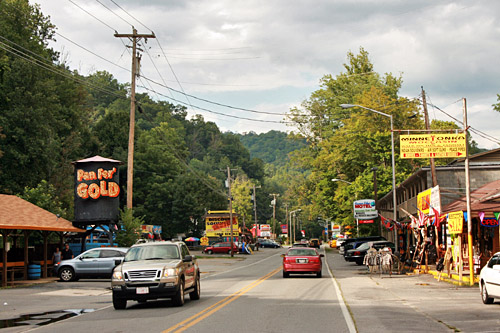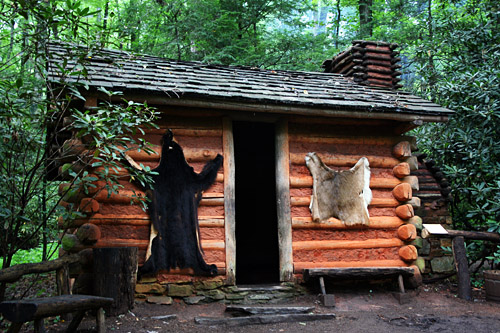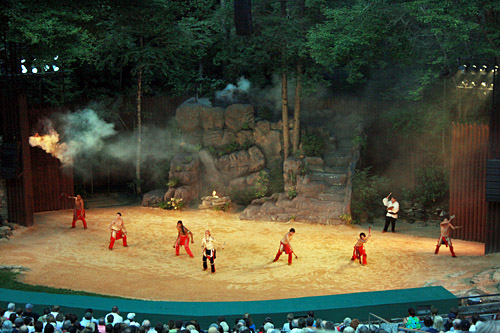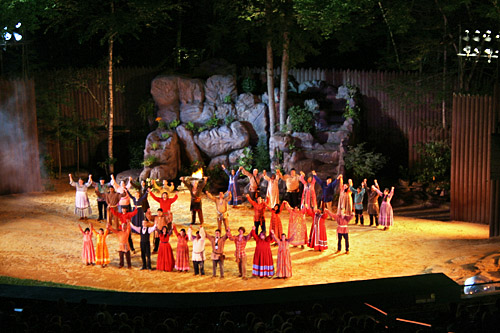Phony teepees, gold panning operations, and stores overflowing with “Indian” souvenirs stamped “Made in Taiwan” dominate the main street in Cherokee, North Carolina. On the sidewalks, performers don garish costumes and perform steps bearing little resemblance to actual Cherokee ceremonial dance. In a shopping center parking lot, kids line up to ride a mechanical bull, while down the street, giant arrows direct tourists to a live bear display. Although located within the Reservation lands of the Eastern Band of the Cherokee Indians, it would be easy to dismiss the town of Cherokee as just another tourist trap and drive right on through. But don’t. Instead, turn at the Cherokee Museum and drive to the top of hill to Oconaluftee Indian Village, where an authentic Cherokee experience awaits.

The Cherokees in Western North Carolina today descend from those who those who hid in the hills, defying removal during the infamous Trail of Tears mandated by President Andrew Jackson, and others who returned, many on foot. Gradually they created a sovereign nation of 100 square miles and, in 1948, established the Cherokee Historical Association to carry out their mission of preserving the history and culture of the Cherokee People. Oconaluftee Indian Village and its sister operation, the Unto These Hills Outdoor Drama are central to those efforts.



The first surprise for most who visit Oconaluftee is the absence of teepees. Cherokee lived in structures initially constructed of wattle and daub spread over a framework of tree limbs, and later in cabins of notched logs with a mixture of mud, straw and animal hair filling the chinks between logs. The cabins surrounded a centrally located, seven-sided Main Lodge, where the tribe gathered each day to discuss issues facing the community. Every Cherokee was a member of one of seven clans, each of which had specific responsibilities within the tribe: members of the Deer clan were relay messengers, Wild Potato clan members oversaw crops and planting, Paint clan was in charge of producing paint for war and dances, Bird clan collected eagle feathers for decoration and ceremonies, Blue clan members were doctors and were responsible for the well-being of children, a Wolf clan member was the chief during war time, and Long Hair clan provided the chief during peace time. Inside the Main Lodge, each person sat in the area assigned to their clan; it was forbidden to sit with another clan, just as it was forbidden to marry within one’s own clan.

Throughout the day at Oconaluftee, presentations in the Main Lodge teach visitors about Cherokee culture and history and dispel some of the more common misconceptions about the tribe. I learned that the Cherokee lived a pastoral life, hunting for game and farming the surrounding land, taking care to rotate crops and let fields lie fallow when crops showed signs that the soil was becoming depleted. In an adjacent sacred square, authentic war dances and reenactments of the Cherokee’s battle with British troops were conducted. Around the outer perimeter of the village, Indian artisans demonstrated traditional crafts of bow and arrow making, basketry, weaving, beading, carving, and dugout canoe construction.

Following dinner in town, I boarded one of the free buses provided by the tribe and headed back up the mountainside to attend Unto These Hills, one of the longest running outdoor dramas in the U.S. As daylight faded a fog machine shrouded the stage in mist. A chill ran up my spine as, one by one, the seven mythical heads of the clans stepped onto the stage, clad in shimmering white robes and elaborate masks. The two-hour play portrayed the story of the Cherokee, tracing them through the zenith of their power, through the heartbreak of the Trail of Tears, and ending in the present day, where the Cherokee people continue to rewrite their place in the world.


Cherokee, North Carolina’s unique, authentic side hides beneath a crassly commercial and overly touristy exterior, but once discovered it is an extremely rewarding experience not to be missed.

I love this for i’m cherokee
Thank you, Aiden. Coming from a local, that means a lot to me.
nice pictures. thanks for sharing.
You’re very welcome, Larry.
My wife and I go every month to the Cherokee Reservation in N.C. and we have a great , we stay at the Harrah’s Cherokee Casino and Resort. We gamble some and I trout fish and we go down and shop, we have a great time every time we go. We meet a lot Cherokee folks and they are all so nice to talk to. My wife and I are half Cherokee.
Hi Barbara, I am an anthropology graduate student at UNCC , with much of my research being devoted to the Eastern Band of Cherokee. In regards to the comment about downtown Cherokee performers not having a “whit of Indian blood” is inaccurate. Anyone “chiefing” as it is called on the Qualla Boundary, must obtain a vendors license verifying that they are Cherokee members specifically of the EBCI. So what you saw was indeed Cherokee people, dressed in Plains Indian style dress. Maybe they didn’t fit the phenotype of what a tourist expects to see when they come into town, but then again many things about the tourism industry in Cherokee was established to meet the “supply and demand” needs of outsiders expecting to encounter the Indian they imagine in their minds from Hollywood. It is an interesting conundrum in which they intentionally misrepresent themselves to make a living and survive on the Boundary, and many are not in agreement with selling the stereotype. One last example, the “authentic” Cherokee sweat shop is as inaccurate as the tee pees, and not part of their culture.
Hello Monica: Thanks so much for sharing your knowledge. I try hard to delve into the culture of the places I visit, but as you can probably imagine it is not easy, especially given that I am often in places for short periods of time. I was apparent that there were differences of opinion within the tribe regarding the display/exploitation of their culture, but the people I interviewed were not willing to share the details of the conflicts, which was understandable. Based on your comment, I removed the comment about not having a “whit of Indian blood,” however since the sweat lodge was a structure at Oconaluftee, I left that photo in the article. Your work sounds fascinating and I suspect you’ve encountered difficulties trying to get to the truth. Keep up the good work!
What a reassuring article. Too many indigenous attractions are anything but authentic and actually take the cause, education and celebration of their culture backwards. I’ve seen it with African tribes, North American Indians and our own aboriginals. Yet when there is an authentic experience emerges it is rewarding and worthy of praise as it takes a lot more effort to achieve this.
You know, Barbara, this Indian Village reminds me a lot of the Polynesian Cultural Center on Oahu – both strive to maintain the heritages of indigenous peoples, and both have some great attractions and activities.